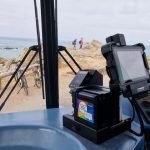While mid-sized, full-weight coaches form a niche part of the market, competition is keen for buyers’ money in this segment. Scania has added further to what is available with its Touring at 10.9m, complementing existing 12.1m two-axle and 13.7m tri-axle models.
The newcomer sits alongside similar-length Scania Irizar products. While Scania acknowledges that none will sell at a rate equalling that of their longer sisters, it believes that the mid-sized coaches each have their places. In the 10.9m Touring’s case, that is as a vehicle that gives a good amount of metal and amenities for the price.
10 stock short Tourings have been delivered, two of which are sold. Brent Thomas Coaches of Tonypandy was the first to take delivery; its example is a 42-seater with a floor-mounted toilet. Scania also has available straight 45-seaters.
Chassis for the Touring range are shipped to Higer in China for bodying. The coaches then proceed to Antwerp. There, interior fittings including seats are installed. While none of the stock 10.9m examples are PSVAR compliant, achieving that is planned for later batches. The additional door will be fitted at the build stage, but the lift and destination display equipment will be added in Belgium.
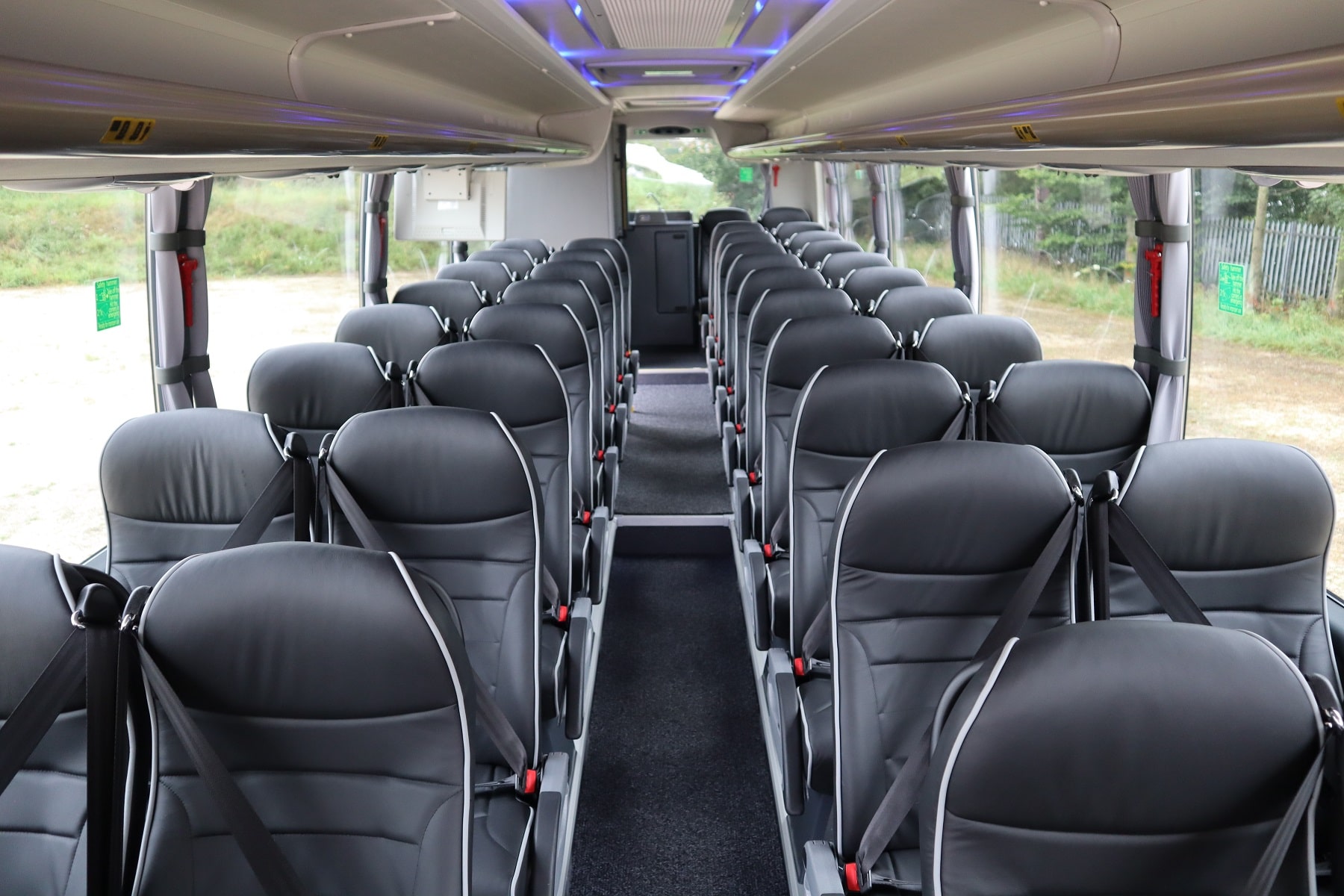
“We are confident that there is a market for this size Touring,” says UK Retail Sales Manager Lee Wale.
“It comes with all the elements of a full-size coach and it is cost effective. Because of that, we believe it will suit private hire and tour work – along with corporate duties, for which its length is ideal.”
As part of Scania’s standard offering to retail coach customers, two years’ repair and maintenance coverage is applied to the 10.9m Touring. That can be extended to suit the purchaser, while Scania Financial Services can support buyers via its usual channels. Days before the first coach was delivered to Brent Thomas, it was made available for a routeone test drive.
10.9m has lots in common with other Scania Touring models
As effectively a shortened version of the 12.1m Touring, the mid-sized model has a lot in common with it. There are also some minor differences, but nothing that is overly noticeable by, or relevant to, passengers.
The test coach is mounted on the K 360 IB chassis, with a front beam axle. Power is from the 9.3-litre DC09 engine developing 360bhp and 1,700Nm of torque. That is harnessed by the Opticruise eight-speed automated manual gearbox. A retarder forms part of the driveline.
Scania (Great Britain) insisted that the toilet in the 10.9m Touring was floor mounted to maximise luggage space. Immediately adjacent, and behind the offside rear wheels, is a powered continental door. As a result, the underfloor area between the axles is entirely clear for luggage. Two manually operated, parallel-lifting doors are fitted on each side.
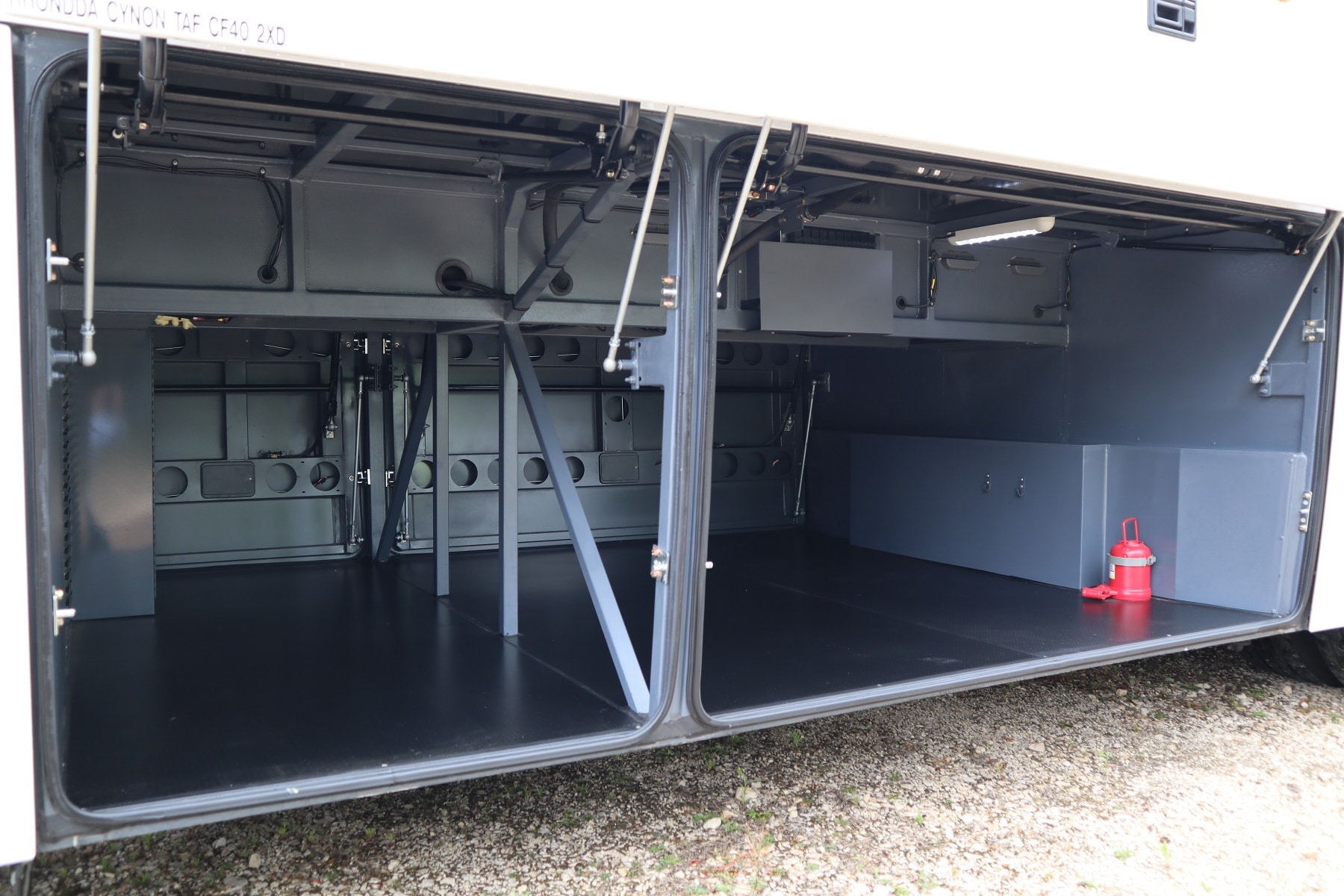
A 310-litre fuel tank with dual fillers sits over the front axle. On the shortest Touring, the AdBlue filler is ahead of the nearside rear wheels.
A wheelbase of 4.90m guarantees good manoeuvrability. However, as all the heavy bits of the 12.1m Touring form part of the mid-sized example, the newcomer is not a lightweight coach. As tested, it tips the scales at 13,036kg unladen and has a 19,500kg GVW.
Well-specified mid-sized motor suits a variety of work
Scania has specified a variety of upholsteries on the first stock coaches, extending from largely moquette-based to full leather. The Brent Thomas example comes with the latter on its Kiel Avance seats, and their black trim imparts a restrained feel to the saloon.
The seats are to a high specification in addition to their leather finish. They have three-point belts, footrests, drop-down tables and magazine nets, while aisle positions have lateral adjustment. USB points are mounted within the side walls.
Dark flooring is fitted, albeit not wood effect. The sunken aisle comes with a carpet. At the front, four steps take passengers to the platform and two more to the gangway. All are edged in yellow. The courier seat is quite bulky and its base is not locked in position when stowed.
Proceeding along the coach, there is a step in the gangway at around the two-thirds mark. The rear row of seats has only two positions, with the space between those and the toilet occupied by a small servery fitted by AD Coach Systems.
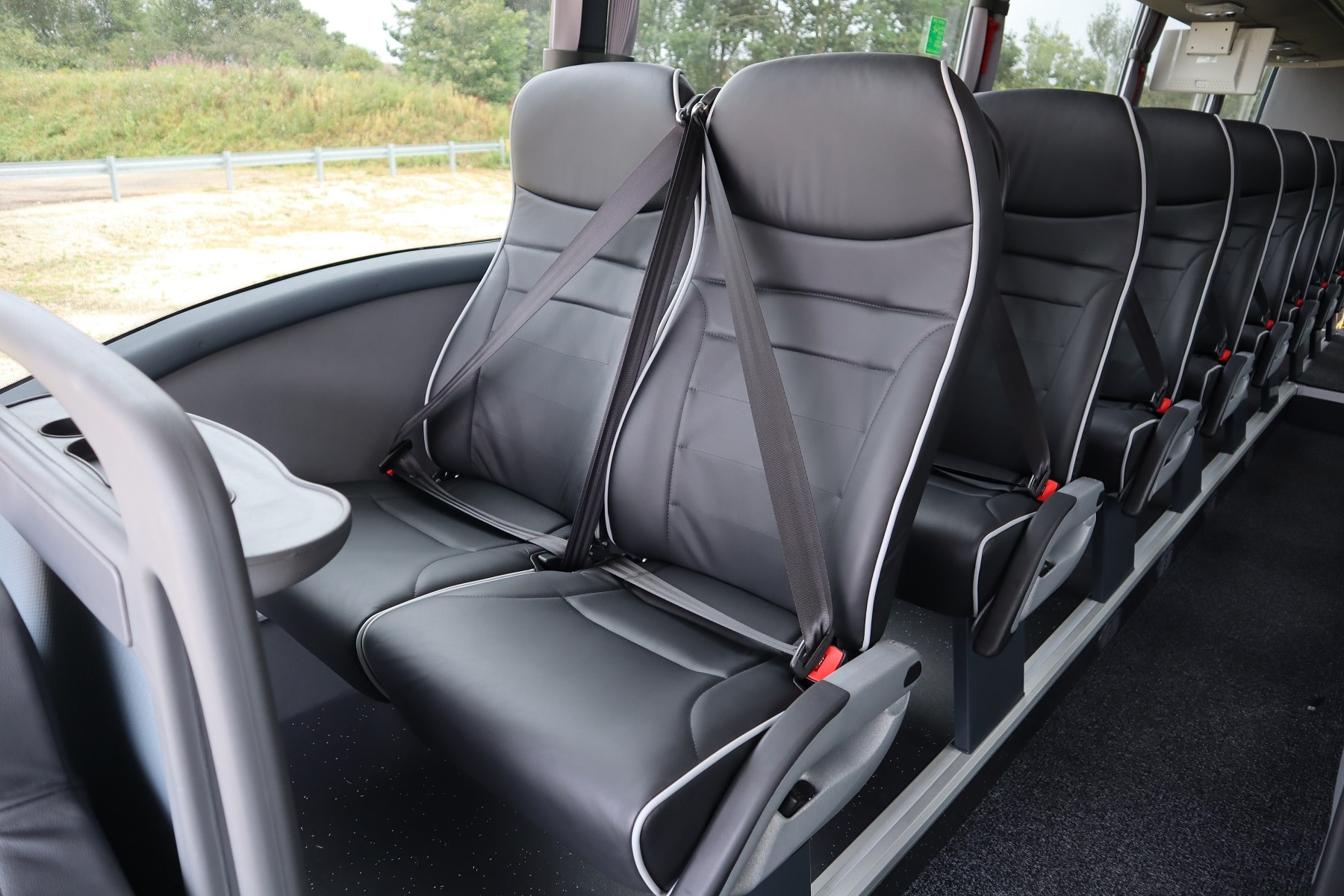
While the floor-mounted toilet has debuted in the 10.9m model, it can also now be specified on the Touring at other lengths.
Two monitors are fitted as standard, coupled to a Bosch entertainment system incorporating a DVD player.
A roof-mounted air-conditioning unit works in tandem with perimeter radiators; climate control is fitted, but an auxiliary coolant heater is not. There is a fridge in the dash.
Cab is well specified – and well heated and cooled
The cab area is standard Scania. As a result it is well laid out, although the tachograph head unit is low to the floor. Storage for smaller items is good, but it’s likely that the driver’s bag will need to go into one of the twin lockable front sections of the luggage racks.
Gullwing mirrors are complemented by a lower-level offside repeater. The signalling window is also powered and heated. Scope for adjustment of the steering wheel is good, and it additionally can be laid almost flat to create space for larger drivers to enter and exit the Isringhausen seat. That comes with the usual refinements, while adjacent to it are a hands-free microphone and a map light.
One thing that the driver will not be is cold. In addition to cab climate control, beneath the seat is an independent heater blower. Meanwhile, a moderately warm day saw the cab temperature brought down quickly by the air-conditioning.
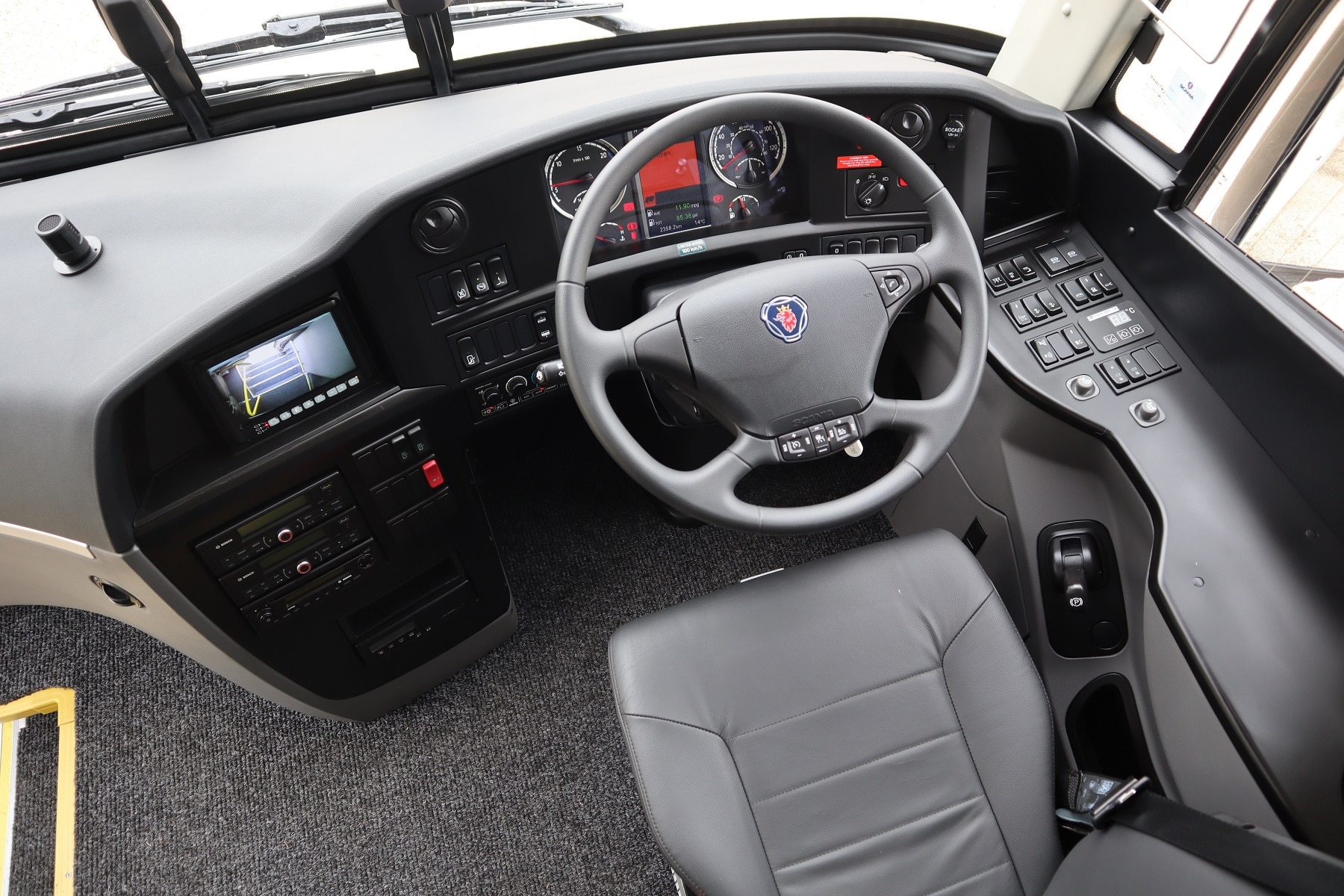
On the dash is a display that feeds to the spoiler-mounted camera when reverse is engaged, and to a camera above the continental door when that is open.
Scania has mastered what some OEMs cannot and positioned the handbrake lever where it is easily accessible to the tallest drivers.
Forward visibility from the Touring is good thanks to its recessed A-pillars. To the side things are a little more difficult for a tall driver or one who sits further back. The B-pillar is slightly in the way at some junctions, and the signalling window frame can sit in the eyeline.
Shorter Touring is as capable on the road as its bigger sisters
The five-cylinder DC09 is ample for the short Touring. Gears are selected via a rotary stalk. The coach initially used first to pull away but later settled on second. Opticruise moves rapidly between ratios and speed is gained rapidly. Coupled to a highly manoeuvrable chassis, that means the coach can push on well along winding rural A-roads.
A power mode is available by further twisting the stalk when in drive. It causes gears to be held longer, but there was no need to utilise it during the test. Scania can disable it should the customer require.
The DC09 revs a little harder than larger engines, but it is also happy to work within the torque band when the cruise control is set. At 50mph, eighth gear can be held at 1,100rpm – where peak torque begins – and pickup is prompt from those speeds. At 62mph, the tachometer shows a shade below 1,400rpm.

Roadholding is good and there is no sign of the ‘nodding’ that can sometimes be apparent on short-wheelbase coaches. Noise levels are also impressively low.
The dash display can impart a great deal of information on both the vehicle and, to a lesser extent, the driver’s performance. Monitoring is provided to the operator free of charge for 10 years by Scania; an important part of that shows the amount of fuel wasted while idling.
More useful consumption is also detailed. On a largely motorway section, the 10.9m Touring turned in 12.7mpg. When rural running to and from Retford and through Blyth was added, the overall return was 11.5mpg – both of which are impressive for what is a heavyweight coach.
10.9m Touring is a worthwhile addition to the Scania range
Although the 10.9m Touring is in a niche part of the market, the number of competitors that are also present demonstrates that there is business to be done with the right product. One of Scania’s aims for the newcomer is for it to provide a cost-effective proposition in this sector.
It is established that having the Touring bodied in China brings a price point benefit, but from a passenger’s point of view that is not relevant. Most of the saloon fittings – including the seats – are added in Europe, and for the driver, the chassis and driveline are no different to other Scania products.

The typical Swedish refinement and low noise levels are both also present. The coach’s interior trim lends itself to corporate work, which the size and capacity of the 10.9m Touring will eminently suit.
But 42 or 45 seats will also satisfy some demand in the private hire, day trip and tour sectors.
When combined with a good amount of luggage space and a keen pricing point, that makes the new addition to Scania’s range perhaps more versatile than would first be thought.
Facts and figures
Engine: 9.3-litre, five-cylinder Scania DC09 112
Power: 265kW (360bhp) @1,900rpm
Torque: 1,700Nm (1,254 lb ft) @1,100-1,300rpm
Emissions: Euro VI using SCR
Tyres: 295/80 R22.5
Length: 10.94m
Height: 3.80m
Width: 2.55m
Wheelbase: 4.90m
Gross weight: 19,500kg
Unladen weight: 13,036kg



























